The Hubble Space Telescope, a joint project by NASA and the European Space Agency (ESA), captured a spectacular sight in space. However, some netizens found it familiar because it was reportedly too similar to the logo of one of the most popular shoe brands in the world.

Nike Logo in Space?
Hubble Space Telescope captured a laser-like jet streaming from an infant star that astronomers said represented its "tantrum." The said outburst traveled supersonically from a very young star that has just been recently formed. ESA wrote in an image description on Monday, March 7, that the glow in the image comes from the jet colliding with gas and dust around the star that astronomers referred to as Herbig-Haro 34 (HH34).
However, it appeared differently to some netizens. According to them, they saw the logo of the most popular sports shoe - Nike! Several onine users commented on the photo shared by NASA's official Instagram account saying they were seeing the Nike logo.
"Saw a Nike logo," @bayronl_ commented. Another netizen agreed, by writing, "same."
"Nike symbol,"ayala_eli21 added.
"I see the Nike swoosh there," vyktheog wrote.
Instagram user _abdelaalim agreed that the photo looked like the Nike swoosh. Another said it was similar to the Nike logo. Several netizens also tagged the brand in the comment section.
When Infant Stars Have Their Tantrums
The photo captured by the Hubble Space Telescope was a beautiful event in the cosmos featuring a tantrum of an infant star. According to NASA, the laser-like jet of gas from the star streaks across the image was a product of an extremely young star, consisted of an incandescent jet of gas traveling at supersonic speeds.
The data from the picture are from a set of Hubble observations of four nearby jets of gas using the Wide Field Camera 3, which is one of the five scientific equipment in the space telescope. The image will help pave the way for future scientific observations with Hubble's successor James Webb Space Telescope (JWST).
The JWST is a collaboration between NASA, ESA, and CSA to observe the young star at predominantly infrared wavelengths. The new telescope can study deep into the dusty envelopes surrounding still-forming protostars and revolutionized the study of jets from young stars, like the one recently shared by ESA.
But these were not the first images of Herbig-Haro objects that Hubble first observed. The space telescope has also found colorful wispy structures a few years back that could potentially help astronomers interpret future observations with JWST.
Close-up View of HH34
Between 1994 and 2007, the Hubble Space Telescope has been following one Herbig-Haro object that they named HH34, which is approximately 1,350 light-years away from Earth and located near the Orion Nebula. Some pictures of HH34 showed how a bright, clumpy jet was ejected from a young star.
According to ESA, its formation signals the birth of the star. Although several bright regions in clumps represent where the material is slamming into other patches of the material, the images show that a couple of bright areas faded over time as the heated cloud began to cool down.
POST NOVO NO BLOG!!!
— Sacani (Space Today) - AKA Gordão Foguetes (@SpaceToday1) March 7, 2022
Hubble faz bela imagem do objeto Herbig-Haro 34 e prepara o caminho para as observações do James Webb!!!
Hubble Faz Incrível Imagem do Objeto Herbig-Haro 34 - https://t.co/YeEArLZPNj pic.twitter.com/bGIAIEM2WF
On the other hand, two regions on the left side of the photo show a couple of bright areas over the 14 years of observations, which suggest some fresh collision sites. HH34 can be seen zipping along more than 434,000 miles (700,000 kilometers) per hour, confined to narrow beams by a strong magnetic field from the star.
ESA shows a series of time-lapse movies that astronomers have made using the Hubble to show the motion of several Herbig-Haro objects. They combined these images taken in 14 years using Hubble's Wide Field Planetary Camera 2 and followed it through three epochs from 1994, 1998, and 2007.
RELATED ARTICLE : Never Before Seen Unique X-Ray Light in The Sky, Possibly an Afterglow of Kilonova Outburst
Check out more news and information on Astronomy in Science Times.
© 2025 ScienceTimes.com All rights reserved. Do not reproduce without permission. The window to the world of Science Times.












